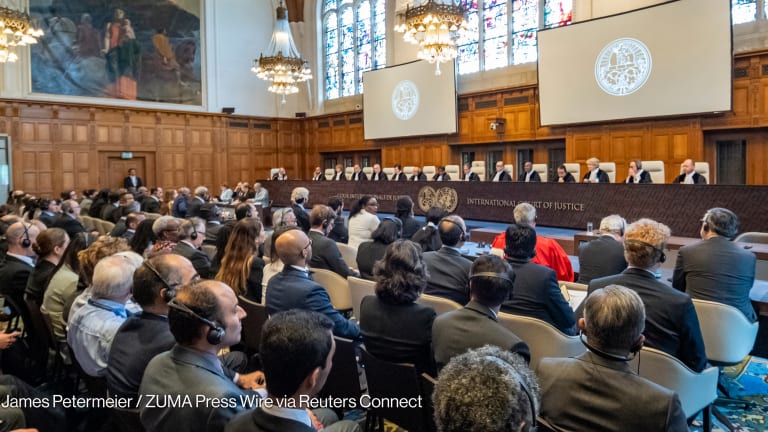
CANBERRA — New research has found that humanitarian responders are not consistently recognizing and respecting each other’s roles, which undermines outcomes for communities. International players have an important role to play in localizing humanitarian responses, but in a backseat position that supports advocacy and accountability — national and local players should be in the driver’s seat.
The report, produced by the Australian Red Cross, Humanitarian Advisory Group, and Humanitarian Policy Group, collates findings from three Pacific case studies: Cyclone Gita in Tonga; Cyclone Pam and the Ambae volcano in Vanuatu; and the 2014 flooding and 2018 Cyclone Liua affecting the Solomon Islands.
“There is definitely a positive shift with international actors increasingly supporting local leadership in responses in the Pacific.”
— Jessica Lees, researcher on the report and leader, Humanitarian Advisory GroupThrough the lessons from the disasters studies, the report creates a new framework for the roles of local and international players. International actors play an important role in asking questions and raising ideas that could support prioritization during a response and only step into a core protection role after asking a series of questions to determine if this is OK.
Getting the balance right
“There is definitely a positive shift with international actors increasingly supporting local leadership in responses in the Pacific,” Jessica Lees, a leader with the Humanitarian Advisory Group and researcher of the report, explained to Devex. “We found a lot of really positive examples but there is still a long way to go. It’s a delicate balance, particularly in making sure that responses are reaching the most vulnerable.”
The key to achieving this balance, Lees said, is strong partnerships with constructive dialogue as a preparedness measure, so that roles, responsibilities, and expectations are clear.
“In Vanuatu, we heard of an example from a national organization where an international organization had set up a protection mechanism that in no way interfaced with what was already there,” she said. “In examples like this, where there may be gaps, national organizations should be supported by international partners to close the gaps rather than duplication.”
For international actors, an important lesson for the research is the importance of listening to local actors best placed to understand the community and vulnerability. This can increase the safety and well-being of women, children, people with a disability, and other vulnerable groups in times of disaster. It is not something currently done well.
But doing it right means doing the groundwork to supporting the local actors in disaster preparedness programs.
“International actors have a wealth of experience from a range of contexts they can bring to support local systems and policies,” Lees said. “They can use this to support national and local partners to advocate for the inclusion and protection of vulnerable groups and accountability initiatives, resource local actors implement protection programs, and ensure that needs assessment processes are capturing information about vulnerable groups.”
In Vanuatu, UNICEF is working with the Ministry of Justice and Social Services on the development and implementation of child protection legislation. This includes measures supporting the protection of children in natural disasters, children living with disabilities, and children who identify as sexual and gender minorities. This is critical in identifying vulnerable groups for an emergency situation — but this work needs to be done before an emergency.
Battleships instead of canoes: Why localization matters in the Pacific
IFRC data and Pacific research confirm localization is still in need of serious action. After the Grand Bargain aimed to increase direct funding by at least 25 percent to local and national responders, humanitarian financing and emergency response still has a long way to go.
There is also a role for international actors during emergencies, around bias. Indeed, there is always a risk that bias can result in groups excluded or marginalized by local or international actors. Where bias is from local actors, Lees recommended that international actors support assessments and identification of recovery activities.
“[This can be done] in a way that respects and supports leadership of national actors but can sensitively raise questions to highlight potential blind spots,” she said. “International actors can also play an important role in supporting national and local actor advocacy efforts to support inclusion of marginalized groups.”
Implementing the framework
The report and its findings will be shared with Pacific actors and broadly with humanitarian responders with the hope that it will play a role in informing policy decisions — including those of governments in preparing and responding to disasters, international donors on how they resource protection, international actors in their support of protection, and national actors in advocating for their core roles of protection communities in disasters.
Identifying and supporting influential local actors is important in the success of localization. For the Pacific, where 95 percent of communities identify as Christian, this includes working to support churches.
“There are some great initiatives that look at transforming perceptions of traditional gender roles that can be harmful,” Lees explained. “A consortium of churches has worked on a theology of gender equality module in a training, supporting churches to empower women and children from violence and support victims of violence.”
This has provided a safe environment for women, children as well as LGBTIQ+ communities in disasters, at a time that can see increased violence and reduced safety for vulnerable groups.
Important to the implementation will be the local context, with the framework’s recommendations between core and complementary roles providing a guide for consultation and discussion.
“It won’t always be possible to stick to these roles, so we’ve provided a framework to guide decisions when it isn’t for international actors to shift from complementary to core,” Lees said.
“At the crux of this is ensuring that the most vulnerable are being reached and ultimately our research shows that local actors are best placed to ensure protection in disasters.”








